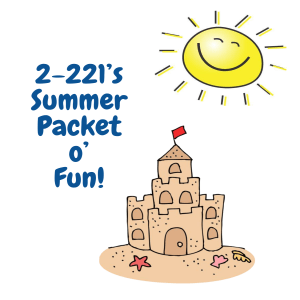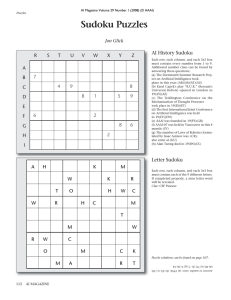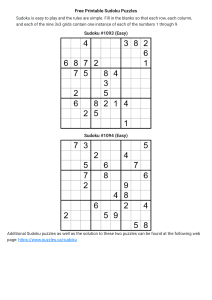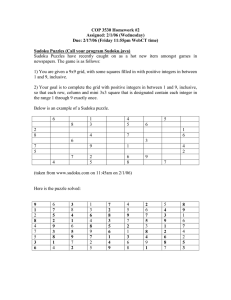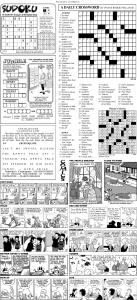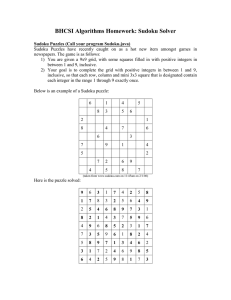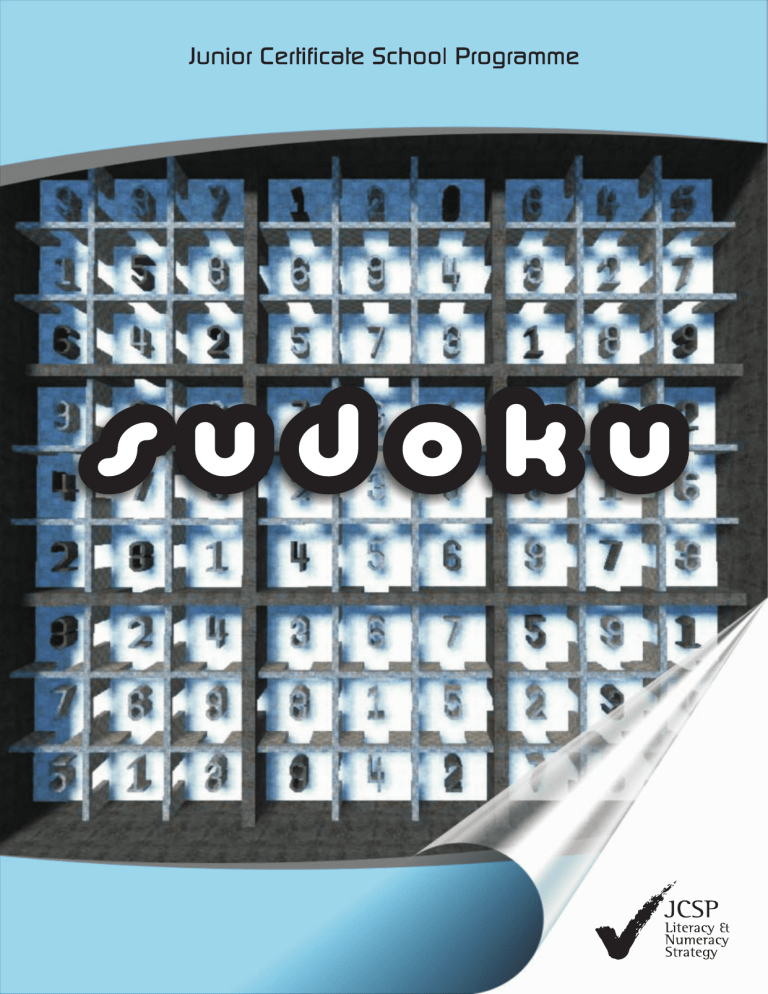
Published in 2009 by Junior Certificate School Programme Support Service Curriculum Development Unit Captains Road Crumlin Dublin 12 Phone:01-453 5487 Fax: 01-453 7659 Email: jcsp@iol.ie Website www.jcsp.ie jcspliteracy.ie Copyright © Junior Certificate School Programme Support Service The Junior Certificate School Programme and the JCSP Literacy and Numeracy Strategy is funded by the Teachers Education Section Department of Education and Science and the European Social Fund. The Junior Certificate School Programme is a national Programme sponsored by the Department of Education and Science and the National Council for Curriculum and Assessment. Written by: Mary Clare Higgins Edited by: Jerry McCarthy and Denise O’Flanagan Benefits of SUDOKU Sudoku is a puzzle game consisting of numbers (or letters or objects). Like any game that can take possession of our students, playing Sudoku has all the elements of a good puzzle game: fun, excitement, and mental challenge. It is simply addictive – in a good and positive sense. However, in addition to the recreational values that Sudoku offers avid gamers, it also offers to develop more than your students’ numerical skills. Cognitive Assessment Cognitive assessment of the grids, in particular the numbers given within the grids, develops the student’s skill in identifying numbers in specific columns and retaining these numbers where necessary, in order to arrive at the correct numerical answer. Elimination By assessing which numbers are already given in particular squares in Sudoku grids, the student can employ the process of eliminating these given numbers to arrive at possible numerical answers. Logical Thinking With the numbers already given and the grids that have to be filled with numbers that have not yet been eliminated as the possible answers, the student can develop such logical thinking skills as deduction and induction. Analysis To arrive at the possible numerical answers, the student needs to analyze using the processes of elimination and trying out a number to see if it fits into the grid. Spatial Relationships To solve a Sudoku puzzle the student must be able to look at the rows, columns and boxes and their relationship to each other at the same time. To become proficient at solving the puzzles students must develop their spatial awareness and understanding of relationships. This is something that can be very boring and hard to teach. However, by playing Sudoku students will naturally increase their ability to spot these things Number Sense It is a fact that the more students work with numbers, the more proficient they become at maths. This can lead to students being able to solve maths problems in their heads easily and rapidly. Patterns and Sequence Sudoku puzzles are often solved by seeing the patterns, sequence, and order of the numbers and this will help students spot relationships in numbers. This skill should transfer to the maths curriculum. Notes for teachers The puzzles in this workbook are grades by grid size and level of difficulty. Many students will not need to start at the basic grids and may be able to go straight to 9 x 9 grids Always model the process for the various grid sizes. Involve students in the process and get them to verbalise the reasons for their answers. By doing this, they will pick up strategies for solving the puzzles from each other. Ensure that students have pencils and erasers. For some students it will be helpful if they pencil in the possibilities for each blank square and erase as necessary as they proceed through the puzzle. The following strategy you may find helpful: • Check each horizontal and each vertical row to see where only one or two gaps occur. Fill in any gaps that have a definite answer. • Next scan each horizontal block and each vertical block to fill in further gaps • Check each square (or rectangle) and fill in missing numbers • Repeat the process until the puzzle is solved! Encourage students to try Sudoku puzzles on newspapers, magazines and on the many websites where they have the option of printing off or completing the puzzles online. Contents Page 4 x 4 Level 1 2 4 x 4 Level 2 3 4 x 4 Level 3 4 4 x 4 Level 4 5 6 x 6 Level 1 6 6 x 6 Level 2 9 6 x 6 Level 3 12 9 x 9 Level 1 15 9 x 9 Level 2 18 9 x 9 Level 3 21 10 x 10 24 16 x 16 (for the expert) 27 1 4 x 4 Level 1 2 4 x4 Level 2 3 Level 3 4 4 x 4 Level 4 5 6x6 Level 1 6 7 8 6 x6 Level 2 9 10 11 6 x6Level 3 12 13 14 9x9 Level 1 15 16 17 9 x9 Level 2 18 19 20 9 x 9 Level 3 21 22 23 10 x 10 24 25 26 16 x 16 27 28
